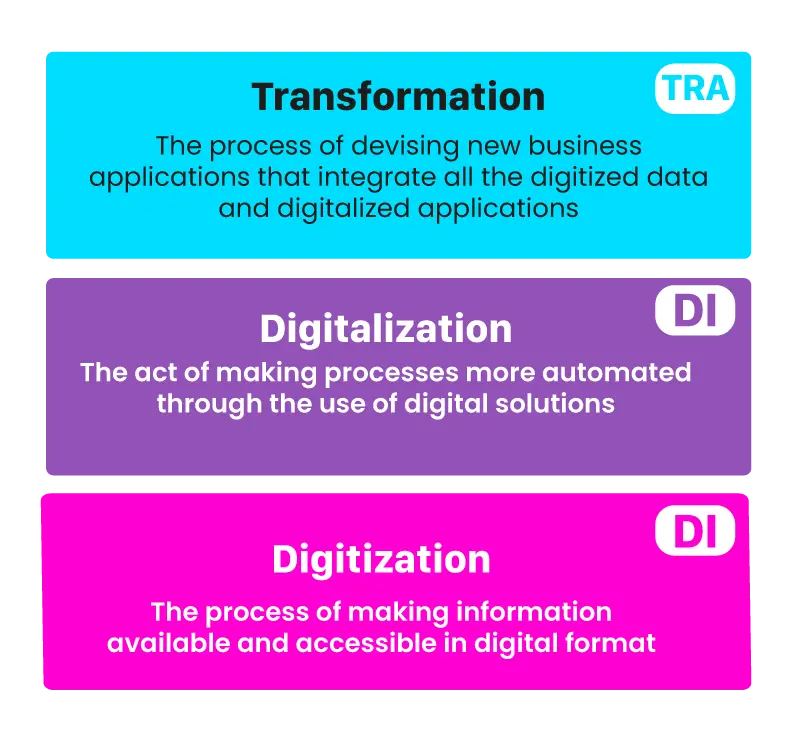Business empowerment through digital transformation can't happen overnight
Digital transformation requires a long-term commitment and a clear plan of action. Organizations must invest in the right technologies, processes, and people to ensure digital transformation initiatives succeed. The digital transformation journey is not easy, but the rewards are great. It can significantly improve customer experience, operational efficiency, and organizational agility. It can also help organizations remain competitive and stay ahead of the curve. Building upon this understanding, we find Digitization, Digitalization, and Digital Transformation as the three-step ladder leading to the ultimate goal of total digital transformation.
The Initial Step: Digitization
The first rung of this ladder is Digitization. It’s the foundation upon which all subsequent steps are built. Here, organizations must commit to converting all analog data and manual processes into digital formats. This not only simplifies data management but also lays the groundwork for advanced digital operations. However, digitization alone is not enough to keep pace with the rapidly evolving digital landscape. It’s merely the start.
For example, the bookstore begins its digital journey by digitizing its inventory management. Instead of using a paper-based system, it starts to record all inventory information into a digital database. This includes data about each book like its title, author, publisher, price, and quantity in stock. The use of a digital database simplifies searching for information and helps maintain real-time stock levels.
The Strategic Move: Digitalization
The second rung is Digitalization. With digitized data and processes at hand, businesses can start re-engineering their operations and business models to leverage digital technologies better. The aim here is not just to replicate analog processes in a digital way but to use technology to streamline, automate, and enhance these processes. The result is improved operational efficiency and a better customer experience, driving a significant part of the value proposition of the digital transformation journey.
For example the bookstore now decides to leverage its digitized inventory data to improve its business processes. It introduces an online ordering system on its website. Customers can browse the digitized inventory, place orders, make payments, and choose either in-store pickup or delivery. This step has digitalized the ordering process, making it more efficient and customer-friendly.
The Ultimate Goal: Digital Transformation
The top rung and the ultimate goal is Digital Transformation. It’s a total paradigm shift in the way an organization operates and delivers value to its customers. More than just using digital technologies, it’s about being digital at the core. A truly digitally transformed organization is one that leverages data and technology to drive innovation, make data-driven decisions, and deliver superior customer experiences. It’s not a one-time project but a continuous process of learning, adapting, and evolving in tune with technological advancements.
For example Now, the bookstore decides to fundamentally change its business model. It creates an online subscription service where customers can access digital copies of books or audio books. Moreover, using data from its online orders and subscriptions, it begins to provide personalized recommendations to its customers. It may even use analytics to predict future demand trends, helping it to manage inventory more effectively. This isn’t just about implementing new technology but about reshaping the entire organization to be digital-first and customer-centric.
Our Philosophy
Did you know about the meaning of DIDITRA brand that...
We decided to create our company's brand by combining those three stages of digital transformation to streamline our customers' digital transformation learning path.
Conclusion
In conclusion, navigating the digital landscape is an incremental, three-step process involving Digitization, Digitalization, and Digital Transformation. Each stage builds on the last, contributing to a larger strategic picture of complete digital transformation. It’s not a quick fix but a long-term commitment that demands investment in the right technology, processes, and people.
Organizations can successfully navigate their digital transformation journey by methodically progressing through these stages. They can unlock unprecedented operational efficiency, customer satisfaction, and competitive advantage, fostering an agile, innovative, and future-ready business in the process. With this perspective, the complexities of the digital transformation journey become navigable, offering enormous potential for growth in the ever-evolving digital era.
DIDITRA Co-Founder & CEO
I was born in 1991 in Tehran, Iran. As a strategy and transformation activist who strives to make sustainable development the basis of the future world, my study and executive activities began in 2009 with a focus on two fields: social and economic development.
The spread of digital technology has led me to focus on developing industries and economic and social infrastructure using a digital transformation approach.





